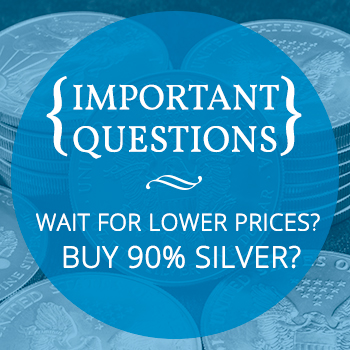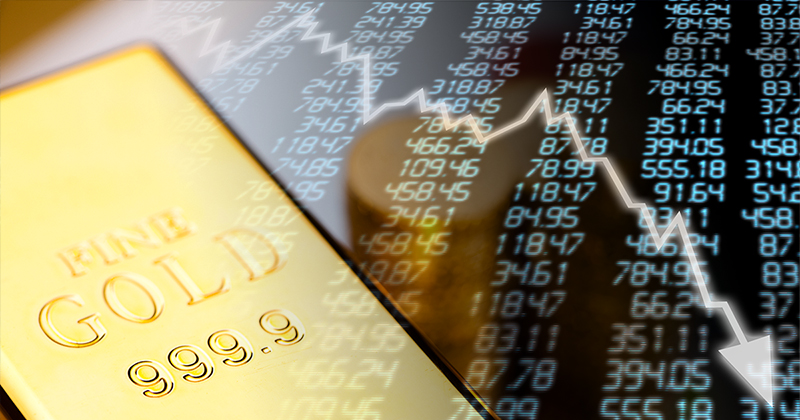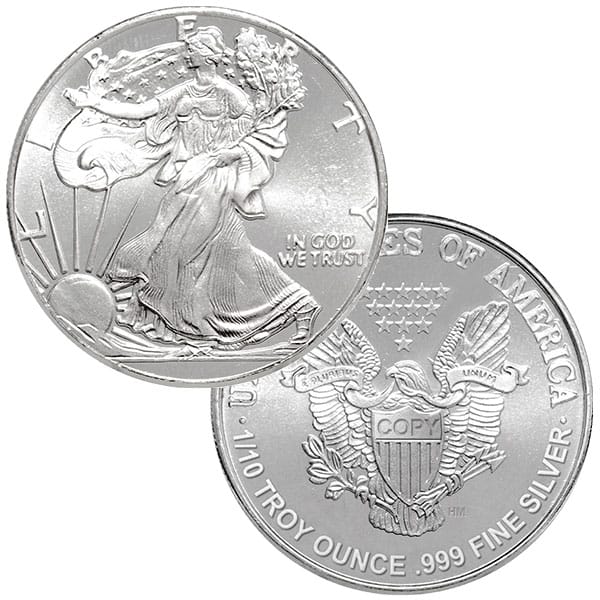In recent months, there are more people than ever either thinking about getting started in precious metals or adding to an existing holding. We are always happy to answer customers’ questions individually. However, we know many people share many of the same questions because we’re hearing them more than once. That’s why we like to publish both these questions and our responses to them.

Question: Precious metals have not fared too well recently. There are lots of people talking about prices still having a long way to fall. Should I wait for lower prices?
Answer: If you are like most people considering buying precious metals, you recognize there is wisdom in diversifying out of paper assets including dollars, stocks, and bonds. The shakier financial markets get, the wiser it looks to get out. The problem is that metals recently have not, for the most part, functioned as an attractive alternative to these conventional assets.
The reason is that gold and silver prices are set in paper futures markets. And these markets are prone to all the same weaknesses: high-frequency trading, bankers manipulating markets to cheat their brokerage clients, central bank interventions, and extraordinary leverage. In other words, prices set there do not fully reflect supply and demand – and they certainly do not tell the whole story.
It is understandably tempting to wait for even lower prices before buying. But with price discovery as broken as it is, relying on price charts alone to make investment decisions is unwise. We strongly suggest investors take a deeper look at activity in the physical market for gold and silver coins, rounds, and bars. The fundamentals there paint a radically different picture.
While a handful of traders may be selling half the annual world production of silver short on the COMEX and other futures exchanges, there is record buying in the physical market.
Mints and refiners are not able to keep up with it. This is at a time when, according to CNBC and most of the financial press, gold is little more than a “pet rock.” What will happen when sentiment in this crowd starts to shift and a whole lot of former “paper bugs” jump into the bullion markets?
Don’t let a fixation on trying to pick the bottom in prices distract you from the more important mission – diversifying out of paper assets. It’s vitally important, and you shouldn’t fool around trying to predict spot prices.
"If you own little to no gold and silver, we believe you are taking a huge risk in not fixing that problem immediately."
If you own little to no gold and silver, we believe you are taking a huge risk by not fixing that problem immediately. You don’t have the luxury of timing the market.
We agree with this insightful analysis in the SRSRocco Report. Investors aren’t going to get advance warning of the next crisis in financial markets. When it happens, most will be caught short.
And by the time it is clear metal prices have bottomed in the paper futures markets, it may be hard, if not impossible, to get actual physical metal.
What’s the Best Silver for the “Worst Case Scenario”?
Question: Should I buy 90% silver U.S. coins? I’d like something I can use if I need to buy food or other necessities when store owners won’t accept dollars. A friend recommended I get a bag of these coins, but the premiums are a lot higher than some of the other choices.
Answer: We too have often recommended pre-1965 silver coins. They are official government-issue coinage, and just about anyone would be confident in their authenticity and value. That, along with their small size, makes them a great option for people who want something to barter and trade. We would still be heartily endorsing them if only they were still low premiums.
Often, in times past, these coins were also one of the cheapest ways to buy silver. Investors could buy them at or near their melt value.
However, “junk silver” coins have become less of a bargain since silver prices began falling in 2011. All of the available inventory in the market must come from investors willing to sell existing stocks. (Obviously, these coins are no longer minted.) Learn more about how much is junk silver worth, then you can understand more about these silver coins when it comes to investing in them.
Most Folks aren’t willing to part with their stash as prices dip lower. There is plenty of bidding for what little does come to market.
As premiums have risen, Money Metals Exchange has been adding alternatives in the form of fractional silver rounds. These 1/10 oz, 1/4 oz, and 1/2 oz pure silver rounds are now very popular, as their small size makes them suitable for barter.
They are more attractive (aesthetically) than circulated pre-1965 coins, and they are marked with their weight and purity.
These days, there is just no way around paying higher premiums for the gold and silver products best suited for bartering. It makes sense to prepare for a currency crisis, so getting a small portion of your holding in small-sized coins or rounds may be well worth a few extra dollars per ounce. We simply suggest investors concentrate the bulk of their buying on lower premium products – 1 oz and larger.

About the Author:
Clint Siegner is a Director at Money Metals Exchange, a precious metals dealer recently named "Best in the USA" by an independent global ratings group. A graduate of Linfield College in Oregon, Siegner puts his experience in business management along with his passion for personal liberty, limited government, and honest money into the development of Money Metals' brand and reach. This includes writing extensively on the bullion markets and their intersection with policy and world affairs.






